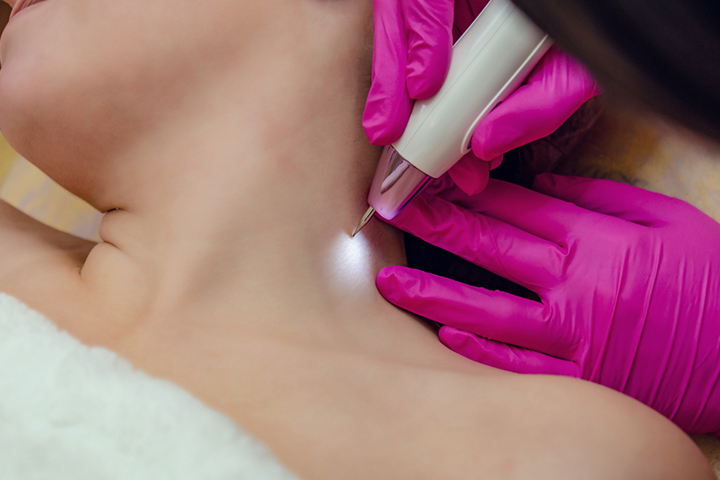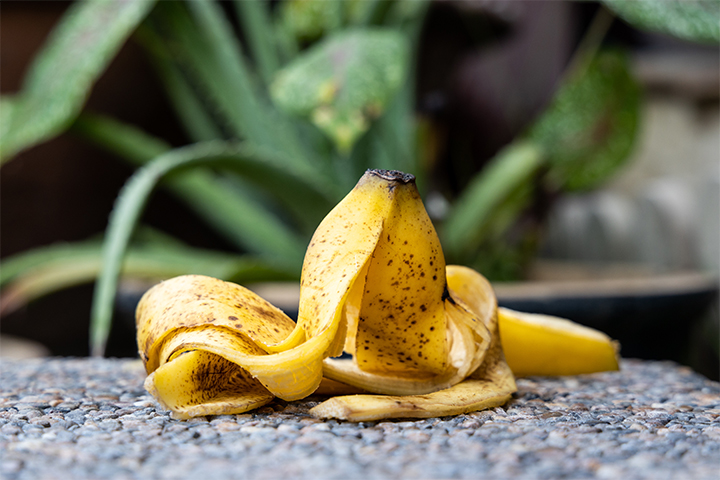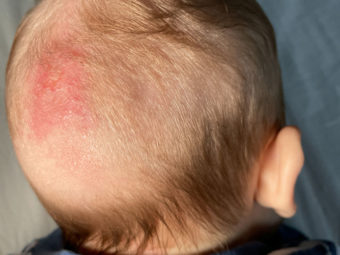
Image: Shutterstock
Skin tags during pregnancy are among the various conditions caused due to fluctuating hormones. These benign skin growths, also known as acrochordons or soft fibromas, are small and soft, made up of loose collagen fibers and blood vessels, and may sometimes resemble moles. They can appear in places, like the creases of your neck, beneath the breasts, underarms, around your genital area, and upper and lower eyelids where the skin brushes against clothes, skin, or jewelry (1). While these tags can appear at any age, ranging from 10-60 years, and vary in size (2 to 5mm) and color (2), some theories imply that pregnancy increases the risk. The specific cause of these skin tags, however, remains unknown. These are normally innocuous and do not require medical attention in most cases. Read this post to know more about skin tags in pregnant women, including their causes, treatments, and so on.
Pregnancy Skin Tags- Where Do They Commonly Appear?
During pregnancy, skin tags can appear at any of the common sites such as the face, neck, upper chest (sometimes on the nipple area), beneath the breasts, and vagina (3).
There is no evidence to suggest that these skin tags might appear at particular places during pregnancy, as they usually appear in areas where there is friction between the skin. They also occur where there are skin folds due to weight gain, so the areas might vary from person to person.
These are harmless skin growths that develop during late pregnancy and go away postpartum. Skin tags occur at any time in your life, just as they do during pregnancy. In the next section, we list the possible reasons for their appearance.
Causes Of Skin Tags – Especially During Pregnancy
In a clinical study on skin changes in pregnancy, it was found that among the 607 pregnant women studied, one of the common dermatological issues found was skin tags (4). There could be many causes for skin tags during pregnancy.
Although the exact cause of skin tags is not known, a few factors are likely to trigger them during pregnancy.
- Weight gain: According to the clinical guidelines of The American College of Obstetricians and Gynecologists, a weight gain of 11 to 22 kgs is recommended for normal to obese women (5). Such weight gain could cause friction between the skin folds in the armpits and neck, resulting in the formation of skin tags.
Image: Shutterstock
- Hormonal fluctuations: Some studies found that hormonal fluctuations might stimulate the growth of superficial skin layers. Thus, some women may experience aggravated skin tags during pregnancy (6). Another study found that the growth of skin tags is dependent on the sex hormones (estrogen and progesterone), which explains the growth of skin tags during puberty (and pregnancy), and why they tend to fade away during menopause (7).
- Other causes: Along with these specific causes that might occur during pregnancy, other causes, such as human papillomavirus, high mast cell count, obesity, insulin resistance, and diabetes mellitus, might also cause skin tags during or before pregnancy. In fact, according to the Centers for Disease Control and Prevention, the prevalence of diabetes diagnosed during pregnancy increased from 6.0% in 2016 to 8.3% in 2021 (6).
Are Skin Tags Unique To Pregnancy?
Skin tags are not unique to pregnancy because they can occur even when you are not pregnant. Also, not all pregnant women may get them during pregnancy. You are likely to develop skin tags if you are prone to them in general.
Some other skin-related pregnancy symptoms and conditions that you may experience include stretch marks, hyperpigmentation, melasma, linea nigra, and skin discoloration. In rare cases, pregnant women may also experience severe skin disorders, such as pruritic urticarial papules and plaques of pregnancy (PUPPP), and enlargement of the sebaceous glands on the areola.
Can Skin Tags Affect The Baby?
Image: Shutterstock
Skin tags do not affect the baby. They are a purely cosmetic issue and could only cause discomfort in worst cases. However, sometimes skin tags could be an indication of insulin resistance or diabetes mellitus. There is no need to worry about them during pregnancy, but if you notice that they are increasing rapidly or are causing discomfort, then seek medical advice.
The skin tags that appeared during pregnancy are said to fade away during postpartum. But if they don’t disappear and are causing discomfort, then you may opt for the following skin care treatments.
Note: These medical treatments should be done under medical supervision only and should never be tried at home.
Treatment For Skin Tags During Pregnancy
Image: Shutterstock
Skin tags do not need treatment. But if they are too large, causing discomfort, you may contact a doctor or visit a dermatology clinic. Treatment includes removal methods such as (8):
- Excision removal (Severing): The skin tag is carefully cut using a scalpel or surgical scissors. It is completely removed with only a tiny white or pink scar seen in that region.
- Cryotherapy (Freezing): Liquid nitrogen is swabbed or sprayed on the skin tag. This gas freezes the tissue and kills the cells, thereby blocking the blood supply to that area. It causes the tag to fall off the skin naturally and heals on its own.
- Hyfrecation (Burning): An electric pulse is passed into the skin tag to damage the cells. The heat burns the stem of the skin tag and causes it to fall off. Anesthetic is applied before the treatment to make it a painless procedure.
Note that these methods might not be safe during pregnancy, so opt for them only after seeking professional advice and if the skin tags are large and causing discomfort.
Can You Remove Skin Tags At Home?
It is not a good idea to try removing skin tags at home. You may be tempted to pull, twist or scratch them, but it could be painful and harmful too. It can cause bleeding, infection, and scarring.
In some cases, they fall off on their own. Therefore, it is wise to wait for natural healing to occur. If the skin tags do not disappear on their own, you may take any of the above treatments after discussing it with your doctor. However there are a few home remedies that you might consider trying, but these natural remedies could take time and need consistent effort.
Home Remedies That Might Work
- Banana Peel: Anecdotal evidence suggests that banana peel might help in drying out the skin tag. Also, banana peel is found to have antimicrobial activity (9). Place a piece of banana peel over the skin tag and cover it with a plaster and let it be overnight. Repeat this until the skin tag falls off.
Image: IStock
- Garlic: Garlic is said to have antiviral properties that could help in removing skin tags caused by the virus (10). Apply crushed garlic on the skin tag, cover it with a bandage, and leave it overnight. Wash the area in the morning, repeat it until the skin tag falls off.
- Tea tree oil: Tea tree oil is said to have antiviral properties, also properly diluted tea tree oil before applying it on the skin tag, so that it could be considered safe during pregnancy (11) (12).
Describing how she employed tea tree oil (melaleuca oil) as a home remedy for her skin tags during pregnancy, Clare, a mother of two, reflects, “I placed one drop of melaleuca oil on my finger and swiped it onto both skin tags. I repeated this three times during the day, then cleaned and refreshed with an organic apple cider vinegar-soaked cotton wool ball before I went to bed and again in the morning before reapplying the melaleuca oil again throughout the day. By day two, the skin tags turned black. By day three, the smaller one wiped away with the ACV, and on day four, the bigger one did the same, admittedly with a big sting (i).”
How Long Does It Take For A Skin Tag To Fall Off?
Few of the skin tags that appear during pregnancy may fall off in a few months after childbirth (3). They either fall off or shrink away due to the lack of blood supply (as compared to blood circulation during pregnancy). Only well-developed and larger skin tags may need a dermatologic intervention.
If you are using any of the home remedies, then it would take a month or two for the results to appear.
 Point to consider
Point to considerCan You Prevent Skin Tags During Pregnancy?
Image: IStock
As pregnancy skin tags occur mainly due to hormonal changes, there is nothing much you can do to prevent them from popping up. You can only avoid the friction of the skin and keep it healthy. You may take the below measures to mitigate the chances of getting skin tags:
- Do not wear tight clothing as it could rub against the skin.
- Avoid jewelry that is tight and makes you feel uncomfortable.
- Keep the skin dry. Shower some talc on regions prone to wetness.
How Are Skin Tags Different From Warts?
Skin tags and warts look alike, but you can look out for these differences (8).
| Skin tags | Warts |
|---|---|
| Soft and smooth | Rough with irregular surfaces |
| Raised and loosely hang from the skin | Flat or slightly raised |
| Non-contagious | Contagious, spread easily |
 Things to know
Things to knowFrequently Asked Questions
1. When should I be worried about skin tags during pregnancy?
Skin tags are usually painless growths on the body. But, if you notice that the tags have been increasing in size, seem infected, and cause pain, you should consult a doctor for a proper diagnosis and treatment.
2. Does a skin tag have roots?
Skin tags are mainly composed of loose fibrous tissue, an attenuated epidermis, and a flat basal cell layer. They are connected to the skin through a pedicle and have no roots (13).
3. Can skin tags spread by touch?
Skin tags are loose skin tissues that hang off the skin. They are not contagious and hence do not spread by touch (14).
4. Can I cut off a skin tag with nail clippers?
Clipping off a skin tag can be painful and may bleed when removed. Unhygienic removal of a skin tag might result in an infection. Hence, it is recommended to consult a doctor for its removal. The doctor might use local anesthesia to extract the skin tag with minimal risks.
Weight gain, gestational diabetes, or changes in hormone levels may cause skin tags during pregnancy. However, they are not a concern, and you may consult a dermatologist if you find them irritating or unsightly. Skin tag removal methods such as excision or cryotherapy may be suggested depending on the condition and the safety of the procedure during pregnancy. Avoid attempting to detach them by scratching or pulling as it may bleed and increase the risk of infections. Instead, you may try some home remedies.
Infographic: Home Remedies And Prevention For Skin Tags In Pregnancy
Skin tags are small, benign growths and are usually not harmful to the mother and baby during pregnancy. But they can be unsightly and uncomfortable; some may remove them for cosmetic reasons. So we provideda few tips to prevent the condition and home remedies to manage them. Consult your OB/GYN before trying them out. Illustration: Momjunction Design Team
Key Pointers
- Skin tags are small benign skin growths of collagen and blood vessels.
- Leading causes of skin tags during pregnancy are weight gain and hormonal changes.
- Skin tags usually grow on the neck, underarms, and genital area but can appear anywhere on the body.
- They can be a cosmetic concern but do not harm the pregnant mother or the child.
- They can be surgically removed by excision, freezing, or burning techniques.
- It is recommended to wait until after pregnancy to have skin tags removed to avoid any potential risk to the baby.

Image: Dall·E/MomJunction Design Team
Personal Experience: Source
MomJunction articles include first-hand experiences to provide you with better insights through real-life narratives. Here are the sources of personal accounts referenced in this article.
i. Skin tag be gone!;https://essentialmum.net/2015/12/12/skin-tag-be-gone/
References
1. Skin Tags (Acrochordon); Harvard Health Publishing
2. Han Ma et al.; Giant skin tag on the labium majorum; Int J Women’s Dermatol (2015)
3. Rita V. Vora, et al.; Pregnancy and Skin; Journal of Family Medicine and Primary Care
4. Rashmi Kumari, et al.; A clinical study of skin changes in pregnancy; Research Gate
5. Weight Gain During Pregnancy; The American College of Obstetricians and Gynecologists
6. Arwa M.HassanaL, et al.; Immunohistochemical study of estrogen and androgen receptors in skin tags; Science Direct
7. Omar El Safoury, Lila Rashid, and Magdy Ibrahim; A Study Of Androgen And Estrogen Receptors Α, Β In Skin Tags; Indian Journal of Dermatology
8. Skin Tags; National Health Service
9. Suraj Premal Kapadia, Pushpa S. Pudakalkatti, and Sachin Shivanaikar; Detection of antimicrobial activity of banana peel (Musa paradisiaca L.) on Porphyromonas gingivalis and Aggregatibacter actinomycetemcomitans: An in vitro study; NCBI(2015)
10. Nader Pazyar and Amir Feily; Garlic in dermatology; Dermatology Reports
11. C. F. Carson, K. A. Hammer,and T. V. Riley; Melaleuca alternifolia (Tea Tree) Oil: a Review of Antimicrobial and Other Medicinal Properties; Clinical Microbiology Reviews
12. Safety of Essential Oils; National Association for Holistic Aromatherapy
13. Skin Tags; National Library of Medicine.
14. The Skinny on Skin Tags: 6 Questions and Answers; Penn Medicine
15. Skin Tags (Acrochordons); Cleveland Clinic
16. Vaginal Skin Tags; Cleveland Clinic



























